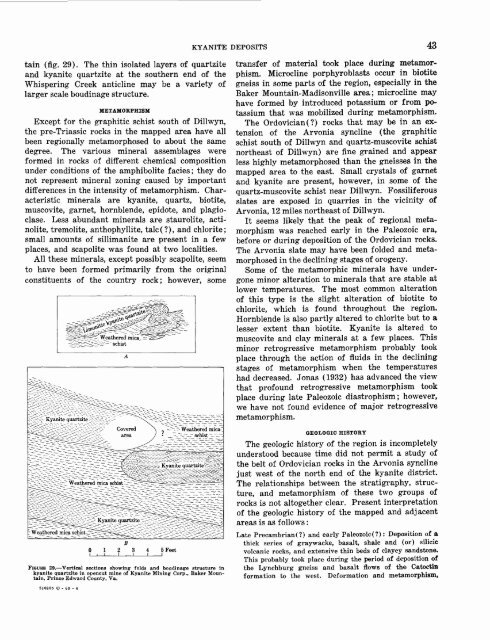Kyanite, Sillimanite, and Andalusite Deposits of the Southeastern ...
Kyanite, Sillimanite, and Andalusite Deposits of the Southeastern ...
Kyanite, Sillimanite, and Andalusite Deposits of the Southeastern ...
You also want an ePaper? Increase the reach of your titles
YUMPU automatically turns print PDFs into web optimized ePapers that Google loves.
KYANITE DEPOSITS 43<br />
tain (fig. 29). The thin isolated layers <strong>of</strong> quartzite<br />
<strong>and</strong> kyanite quartzite at <strong>the</strong> sou<strong>the</strong>rn end <strong>of</strong> <strong>the</strong><br />
Whispering Creek anticline may be a variety <strong>of</strong><br />
larger scale boudinage structure.<br />
METAMORPHISM<br />
Except for <strong>the</strong> graphitic schist south <strong>of</strong> Dillwyn,<br />
<strong>the</strong> pre-Triassic rocks in <strong>the</strong> mapped area have all<br />
been regionally metamorphosed to about <strong>the</strong> same<br />
degree. The various mineral assemblages were<br />
formed in rocks <strong>of</strong> different chemical composition<br />
under conditions <strong>of</strong> <strong>the</strong> amphibolite facies; <strong>the</strong>y do<br />
not represent mineral zoning caused by important<br />
differences in <strong>the</strong> intensity <strong>of</strong> metamorphism. Characteristic<br />
minerals are kyanite, quartz, biotite,<br />
muscovite, garnet, hornblende, epidote, <strong>and</strong> plagioclase.<br />
Less abundant minerals are staurolite, actinolite,<br />
tremolite, anthophyllite, talc(?), <strong>and</strong> chlorite;<br />
small amounts <strong>of</strong> sillimanite are present in a few<br />
places, <strong>and</strong> scapolite was found at two localities.<br />
All <strong>the</strong>se minerals, except possibly scapolite, seem<br />
to have been formed primarily from <strong>the</strong> original<br />
constituents <strong>of</strong> <strong>the</strong> country rock; however, some<br />
5 Feet<br />
FIGURE 29. Vertical sections showing folds <strong>and</strong> boudinage structure in<br />
kyanite quartzite in opencut mine <strong>of</strong> <strong>Kyanite</strong> Mining Corp., Baker Mountain,<br />
Prince Edward County, Va.<br />
transfer <strong>of</strong> material took place during metamorphism.<br />
Microcline porphyroblasts occur in biotite<br />
gneiss in some parts <strong>of</strong> <strong>the</strong> region, especially in <strong>the</strong><br />
Baker Mountain-Madisonville area; microcline may<br />
have formed by introduced potassium or from potassium<br />
that was mobilized during metamorphism.<br />
The Ordovician(?) rocks that may be in an extension<br />
<strong>of</strong> <strong>the</strong> Arvonia syncline (<strong>the</strong> graphitic<br />
schist south <strong>of</strong> Dillwyn <strong>and</strong> quartz-muscovite schist<br />
nor<strong>the</strong>ast <strong>of</strong> Dillwyn) are fine grained <strong>and</strong> appear<br />
less highly metamorphosed than <strong>the</strong> gneisses in <strong>the</strong><br />
mapped area to <strong>the</strong> east. Small crystals <strong>of</strong> garnet<br />
<strong>and</strong> kyanite are present, however, in some <strong>of</strong> <strong>the</strong><br />
quartz-muscovite schist near Dillwyn. Fossiliferous<br />
slates are exposed in quarries in <strong>the</strong> vicinity <strong>of</strong><br />
Arvonia, 12 miles nor<strong>the</strong>ast <strong>of</strong> Dillwyn.<br />
It seems likely that <strong>the</strong> peak <strong>of</strong> regional metamorphism<br />
was reached early in <strong>the</strong> Paleozoic era,<br />
before or during deposition <strong>of</strong> <strong>the</strong> Ordovician rocks.<br />
The Arvonia slate may have been folded <strong>and</strong> metamorphosed<br />
in <strong>the</strong> declining stages <strong>of</strong> orogeny.<br />
Some <strong>of</strong> <strong>the</strong> metamorphic minerals have undergone<br />
minor alteration to minerals that are stable at<br />
lower temperatures. The most common alteration<br />
<strong>of</strong> this type is <strong>the</strong> slight alteration <strong>of</strong> biotite to<br />
chlorite, which is found throughout <strong>the</strong> region.<br />
Hornblende is also partly altered to chlorite but to a<br />
lesser extent than biotite. <strong>Kyanite</strong> is altered to<br />
muscovite <strong>and</strong> clay minerals at a few places. This<br />
minor retrogressive metamorphism probably took<br />
place through <strong>the</strong> action <strong>of</strong> fluids in <strong>the</strong> declining<br />
stages <strong>of</strong> metamorphism when <strong>the</strong> temperatures<br />
had decreased. Jonas (1932) has advanced <strong>the</strong> view<br />
that pr<strong>of</strong>ound retrogressive metamorphism took<br />
place during late Paleozoic diastrophism; however,<br />
we have not found evidence <strong>of</strong> major retrogressive<br />
metamorphism.<br />
GEOLOGIC HISTORY<br />
The geologic history <strong>of</strong> <strong>the</strong> region is incompletely<br />
understood because time did not permit a study <strong>of</strong><br />
<strong>the</strong> belt <strong>of</strong> Ordovician rocks in <strong>the</strong> Arvonia syncline<br />
just west <strong>of</strong> <strong>the</strong> north end <strong>of</strong> <strong>the</strong> kyanite district.<br />
The relationships between <strong>the</strong> stratigraphy, structure,<br />
<strong>and</strong> metamorphism <strong>of</strong> <strong>the</strong>se two groups <strong>of</strong><br />
rocks is not altoge<strong>the</strong>r clear. Present interpretation<br />
<strong>of</strong> <strong>the</strong> geologic history <strong>of</strong> <strong>the</strong> mapped <strong>and</strong> adjacent<br />
areas is as follows:<br />
Late Precambrian(?) <strong>and</strong> early Paleozoic(?): Deposition <strong>of</strong> a<br />
thick series <strong>of</strong> graywacke, basalt, shale <strong>and</strong> (or) silicic<br />
volcanic rocks, <strong>and</strong> extensive thin beds <strong>of</strong> clayey s<strong>and</strong>stone.<br />
This probably took place during <strong>the</strong> period <strong>of</strong> deposition <strong>of</strong><br />
<strong>the</strong> Lynchburg gneiss <strong>and</strong> basalt flows <strong>of</strong> <strong>the</strong> Catoctin<br />
formation to <strong>the</strong> west. Deformation <strong>and</strong> metamorphism,<br />
510205 O - 60 - 4
















